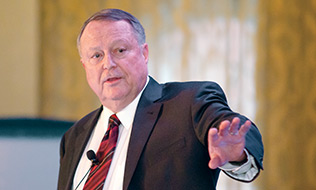

When Searles Valley Minerals Inc. upgraded its pension plan offerings, the situation appeared complicated. The average age of the 761 plan participants at the Kansas-based mining company was 47, and turnover was low. With many employees anchored in their careers, lifestyles and habits, change wasn’t necessarily a priority.
“Inertia can be a powerful force,” said Larry Schmidt, the company’s director of human resources, during Benefits Canada’s Defined Contribution Plan Summit in February. “But we found that by taking the time to know participants and test their parameters with the new design, most went along willingly.”
Read: DC Plan Summit: Mandatory e-learning among British company’s large DC revamp
Following an extended career in the U.S. Marine Corps, Schmidt joined Searles Valley Minerals in 1994. He’s a long-time member of the administrative committee of its 401(k) plan and currently serves as its secretary. An initial spur for action occurred when two of the original three committee members changed and the group took on a plan advisor.
During a broad review, the new committee evaluated the plan’s modest incremental performance and found there was room for improvement. For example, newly hired employees tended to opt for the most conservative investment fund and were reluctant to increase participation levels.
With some of the findings in mind, the group took several steps to improve projected retirement outcomes. They included instituting automatic re-enrolment into an appropriate target-date fund, moving participants to a minimum four per cent contribution rate and the introduction of limits on the amount employees could borrow against their retirement assets. At the same time, the company introduced automatic escalation of contributions up to a 10 per cent cap.
Read: DC Plan Summit: Direct managers key to helping Coca-Cola manage DB/DC transition
What were the results? Since the changes took effect, 79.5 per cent of employees are now on track to replace 75 per cent or more of their income in retirement. “There was literally no push back,” said Schmidt. “We found that leadership mattered. When our committee overcame its inertia, plan participants did, too.”
Get a PDF of this article.
Read more coverage from the 2018 DC Plan Summit.
